#Black cotton soil farming
Explore tagged Tumblr posts
Text
Patamda's Red Gold: Tomatoes Shine in National Market
Local produce gains fame, farmers seek infrastructure boost East Singhbhum’s agricultural prowess comes to the forefront as its tomatoes capture attention across multiple states. JAMSHEDPUR – The tomato production in the East Singhbhum district, especially from Patamda and Bodam blocks, is gaining increasing attention in markets across the country. Tomatoes from East Singhbhum, lately, have…
#Agricultural infrastructure needs#जनजीवन#Black cotton soil farming#Cold storage facilities Jharkhand#East Singhbhum agriculture#Farmer challenges India#Life#One District One Product scheme#Patamda tomatoes#Rural economic development#sustainable farming practices#Tomato market demand
0 notes
Text
Writing Notes: Mushrooms
The edible parts of fungi are the fruiting bodies that are produced very dramatically by huge spreading masses of mycelia, which draw their nutrients as parasites from roots and decaying vegetation.
BAY BOLETUS (Boletus badius)

Usually found in woodlands, this fungus is pale to brown in colour.
Has light yellow pores on the underside and these stain blue if damaged.
The flesh also stains a bluish colour when cut and smells very mushroomy.
The stalk has no frills but is smooth from base to cap.
Can be stored by slicing and drying or flash freezing.
They taste fine raw when sliced and make great soup.
SHAGGY INK CAP (Coprinus comatus)

Very common but distinctive mushroom.
Easy to identify with its egg-shaped shaggy cap.
Often grows on newly disturbed ground in large clusters.
The cap is covered with beautiful white scales and there is no veil on the stem when the cap opens to a bell shape with a dark black underside.
Need to be young and fresh to make good eating.
Shaggy ink caps make a wonderful mushroom soup.
These mushrooms do not store well, so they are best used fresh.
GIANT PUFFBALL (Langermannia gigantea)

Can grow to 80 cm diameter.
The huge white ball of a giant puffball is not hard to identify.
Must be used young before the spores have time to develop and the insects have time to take their share.
Slice them up like rump steak to cook them.
By themselves they have little flavour, but fried quickly with a little bacon they are delicious.
HORSE MUSHROOM (Agaricus arvensis)

Can be found on old pastures that has been grazed by horses or cattle.
Has a slight aniseed smell and does not shrivel up when cooked.
Just beware you don’t over-indulge if you are lucky enough in these times of chemical farming to find a crop of these.
The cap of the horse mushroom may be yellowy in colour, but be careful not to confuse it with the “yellow stainer” fungus, which will make you ill.
CHANTERELLE (Cantharellus cibarius)

May be found in woodland clearings.
Seasoned mushroom hunters will keep their locations a close secret as they tend to grow in the same places each year.
Are fairly small – up to 4 inches (10 cm) across but usually smaller – with a distinctive yellow colour and a slight smell of apricots.
The caps become like small, fluted trumpets as they age and the gills are heavy, irregular and run down the stems.
Best stored in good olive oil or in spiced alcohol.
PARASOL (Macrolepiota procera)

Usually found in open fields and has large brown scales in a symmetrical pattern around a pronounced central bump.
The cap can grow up to 10 inches (25 cm) across and the gills are white.
The stem is long and tough with a large ring around it.
Will dry well for storage.
Make a delicious dish by dipping pieces of the parasol in batter and deep frying.
PENNY BUN (Boletus edulis)

Also known as the “cep” mushroom and is a great prize for the mushroom hunter, as it has an unusual nutty flavour.
Found in woodland or sometimes in heather with dwarf willows, the “cep” can grow quite large – over 2 pounds (1 kg) in weight.
When picking, cut the cap in half to check for maggots. These work their way up through the stems.
Its cap looks just like freshly baked bread.
The colour darkens as the mushroom ages.
The underside will have yellow pores, not gills.
The stem is bulbous and solid white with brown stripey flecks.
Stores well if dried in thin slices.
HONEY FUNGUS (Armillaria mellea)

This yellowy-brown fungus is a tree-killer – but highly edible for humans.
The active part of the fungus is a black cord-like rhizomorph that covers huge areas under the soil and seeks out trees, which it destroys.
Normally grows straight out from trees and stumps, usually in large clumps.
The flesh is white and smells strong and sweet.
The gills vary from off-white to brown and the stalks are tough, often fused together at the base and with a white, cotton-like ring below the cap.
The caps become tough if you dry them so it’s best to freeze.
ORANGE PEEL (Aleuria aurantia)

An extraordinary, brightly coloured and very striking fungus.
Found commonly in large clumps in grassland on bare earth from autumn to early winter. The caps soon become wavy and are of fairly robust texture.
Quite small – up to 2 inches (5 cm) across – the fungus is bright orange on top and a lighter shade on the velvety underside.
These store well if dried.
WOOD MUSHROOM (Agaricus silvicola)

Only found in woodland.
A more delicate version of its close relative, the horse mushroom.
Does not grow out of a volval bag like the death cap and its gills are pink to brown in colour, not white.
The flesh does not discolour when cut and the smell is of a slight aniseed.
The cap is a creamy-yellow colour that darkens as it ages and is smaller than the horse mushroom, growing to only 4 inches (10 cm).
THE PRINCE (Agaricus augustus)

Resembles a stocky version of the parasol.
Grows up to 10 inches (25 cm) wide and is found in woodland.
The top is flecked with brownish scales.
The gills are off-white when young, turning dark brown with age.
The flesh is strong white and smells of mushroom.
The stem is very strong and often scaly with a large floppy ring under the cap – it is too tough to make good eating unless cooked in stews.
It has a strong flavour and can be frozen or dried for excellent winter meals.
FIELD MUSHROOM (Agaricus campestris)

Undoubtedly the best known of all mushrooms, before the days of chemical farming whole fields would be covered by the prolific field mushroom.
Get up early after a hot summer spell has been followed by rain to pick.
The silky white caps grow up to 4–5 inches (10–12 cm), the gills are pink, and the smell mushroomy.
The ring around the stems is very fragile and often missing.
Maggots can be a problem – check older specimens by cutting through the stems.
Can be stored by flash freezing or drying.
WHERE TO LOOK

You will always harvest your best specimens early in the morning. Fungi grow in a wide variety of places, but they will not tolerate chemical fertilizers or sprays.
They say it will take 20 years for the horse mushroom to appear in grassland after the use of chemicals has been stopped.
In fact, the majority of edible fungi grow in the proximity of woodland and many have close symbiotic relationships with particular tree roots.
But wild grassland does always produce an excellent crop of fungi every autumn and you will find each season’s crop in similar places to the previous year’s.
WHAT TO AVOID

There is probably no need to warn you of the fly agaric, as this bright red and white spotted fungus is so well known.
The most dangerous of all fungi is the death cap (Amanita phalloides).
A single death cap contains enough toxins to kill several people:
Usually it grows in woodland, particularly with oak trees. It can vary in colour, being similar in size to a field mushroom, but its characteristic features are white gills on the underside and a “volval” bag at the base. Any fungi growing from a “volval” bag are best left well alone for many are poisonous.
A death cap has white spores, not brown like most edible mushrooms.
Another mushroom to avoid is the “yellow stainer”, easily confused with field or horse mushrooms:
It has the distinctive feature of turning bright yellow when bruised or cut. It also smells rather like disinfectant.
NOTE. There is no easy way to determine whether a fungus is toxic just by looking at it. You should never ingest any unknown fungi. Fungal fruiting bodies can be picked out of the planter pot and thrown in the trash if there is a concern that pets or young children could ingest them.
Sources: 1 2 ⚜ Writing Notes & References ⚜ Food History
#mushrooms#writing reference#writeblr#dark academia#cottagecore#spilled ink#literature#writers on tumblr#writing prompt#mcyology#poets on tumblr#creative writing#naturecore#writing inspiration#writing ideas#light academia#nature#food#forestcore#fungi#writing resources#requested
82 notes
·
View notes
Text

Today In History
Dr. George Washington Carver, scientist and discoverer of over 300 products from the peanut, was successful in getting a Branch Agricultural Experiment Station and Agricultural School at Tuskegee Normal School on this date February 15, 1897.
Born a slave on a Missouri farm in 1865, Carver became the first black student and the first black faculty member at what is now Iowa State University. The well-respected botanist led the bacterial laboratory work in the Systematic Botany Department. But at the urging of Booker T. Washington, Carver moved to Tuskegee Institute in Alabama to serve as the school’s director of agriculture. He used his agricultural research to help black farmers become more self-sufficient and less reliant on cotton, the major cash crop of the South.
Carver developed numerous products and processes that expanded the range of Southern agriculture. At Tuskegee, Carver developed his crop rotation method, which alternated nitrate-producing legumes such as peanuts and corn with cotton, which depletes the soil of its nutrients. His innovations have been credited with the South’s economic survival in the early part of the 20th century.
CARTER™️ Magazine
#george washington carver#carter magazine#carter#historyandhiphop365#wherehistoryandhiphopmeet#history#cartermagazine#today in history#staywoke#blackhistory#blackhistorymonth
90 notes
·
View notes
Text
OBSESSED with the fact that the infamous “gross American food” poll is fully just poor people food that people still make/buy either because it was passed through their family or because they’re still poor. Allow me to elaborate. Here’s the poll if you’ve managed to avoid the discourse:
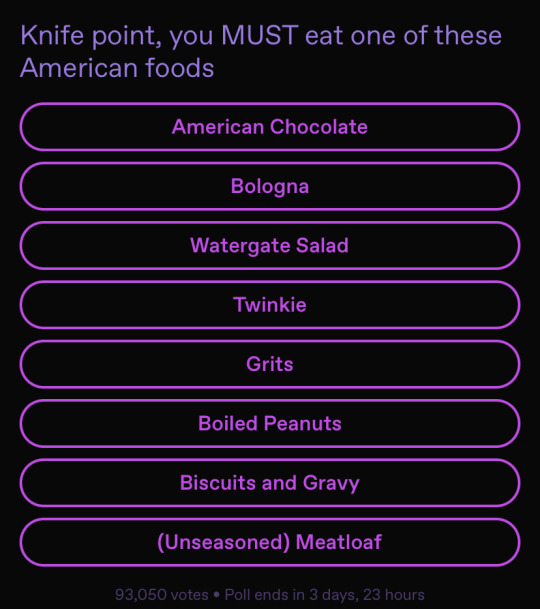
American Chocolate tastes different because of two factors: the majority of our cacao comes from South America unlike Europe which generally imports from Africa (moving product farther costs more money). Also, American chocolate is only required to have 10% cacao as opposed to Europe’s 20% (using less cacao and supplementing with readily available sweeteners like corn syrup costs less money). In fact, the very first American Chocolate company (Baker Chocolate Company) was so aware of how much less wealthy the early US was than Europe’s established market for chocolate, that their bars came with a money back guarantee for anyone who was disappointed with the sweets. The current financial situation in the US is well known to the rest of the world- of course we still make and eat cheap chocolate, the bones of our country are exploitation. Also, the dairy content is lower in American chocolates which makes them more shelf stable. Shelf stable foods are important for communities living paycheck to paycheck who have money for a chocolate bar right now but won’t for their kid’s birthday in a week.
Bologna feels self explanatory to me. It’s made of literal scraps from the meat production industry that are then turned into a “sausage” and cured to give the product more longevity. I like fried bologna because it was cheaper for my dad’s parents when he was a kid. My dad likes bologna for the same reason.
Watergate Salad is made of shelf stable ingredients. Many desserts require eggs or dairy that can be expensive and expire quickly. Those desserts then get stale if they aren’t eaten immediately. Canned fruits, pistachio pudding mix, and cool whip (which is hydrogenated oil and very little dairy) will all keep for a while. You can buy them in bulk and put them in your cabinets or freezer until you want to use them and then the salad itself will keep in the fridge. See again the importance of shelf stable foods to impoverished communities.
Twinkies are cheap and go stale slowly. See again the importance of shelf stable foods in impoverished communities.
Grits, Boiled Peanuts, and Biscuits and Gravy are all southern comfort food staples. I was born and raised in north Georgia, it’s very important to me to note that almost all southern food was co-opted from freed slaves by poor rural white folk in the south. Plain grits can be deeply unappetizing but they are cheap and self stable. You can add butter and salt or even seasoned meat and veggies. Grits are rarely a whole meal all to themselves and when they are you add some cheese or salt at the very least. George Washington Carver (a black man many people outside of Georgia should acquaint themselves with at least a little better) turned peanuts into a massive cash crop in Georgia because they are nitrogen fixing! They replace the nitrogen other cash crops (like cotton and tobacco) take out of the soil. In order for your fields to stay viable, you have to plant something like this every once in a while, so most farmers had peanuts themselves or had a neighbor growing peanuts. Boiling them is a quick, easy way to get salt on the nuts themselves. The water soaks through the shells and seasons and softens the nuts. Water is free and peanuts will keep until the fats start to go south, no wonder they picked up popularity among rural folk and travelers alike. Biscuits and gravy are another scrap food. A good sausage gravy is made of leftover sausage and southern biscuits are a savory, buttery carb that is filling and gives you energy you need somewhere like a farm. The negative stereotypes of the south are pervasive and often rooted in racism. Find someone whose grandma has been making these foods her whole life before you form an opinion.
Meatloaf is seasoned more often than not. Like. Sorry you ate meatloaf that wasn’t salted. Anyway, meatloaf is another scrap food! Meat scraps are ground up and then formed into a loaf. Most people put tomato sauce or ketchup on it. Canned tomato products are, you guessed it, shelf stable, and can also be canned at home fairly safely.
The United States at large is not ignorant of the world around it. We are aware that other foods exist. Either we are choosing to eat these or our financial situations are backing us into corners. This is all without even touching upon the prevalence of food deserts in low-income, minority communities in the US. If you’re aware of all this and you really just want to critique the wealth disparity in the US, punch up. Go after the guys with money, not the food that the rest of us find joy in making out of the scraps. Also, making fun of the British is always punching up. Maybe if you had caused fewer wealth disparities that directly impacted the food eaten in other countries, we would be nicer about yours.
#I wrote all this on mobile#so i couldn't link sources#but google is free#american food#american food poll#biscuits and gravy#american chocolate#bologna#watergate salad#twinkies#grits#boiled peanuts#meatloaf#long post
175 notes
·
View notes
Text
PLANET PROFILE: Harvest
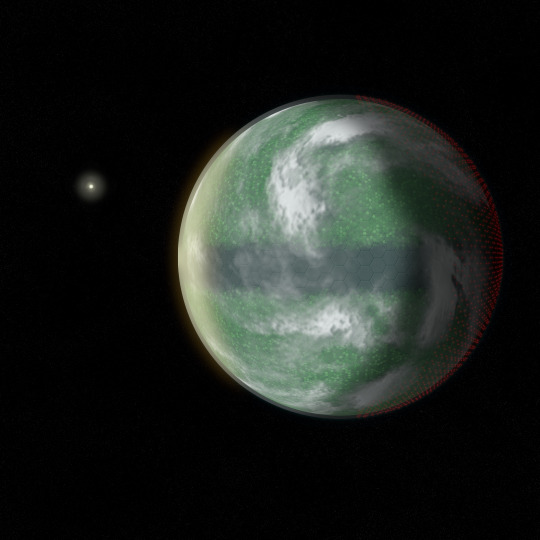
Orbiting Alpha Centauri B, Harvest, as it's colloquially known, was humanity's first foray into both paraterraforming of an entire world and the first attempt at large-scale agriculture outside the Solar System.
A small world in orbit around the K-type star, roughly halfway between Earth and Mars in size, Harvest was originally a barren rock with no water, no life and a thin atmosphere of toxic gases. The world was initially mined for minerals, but then a new project was considered thanks to its close proximity to its parent star.
This involved the creation of a worldhouse, an huge translucent sphere situated just above the Kármán line, which would serve to control the planet's temperature, shield the surface from cosmic radiation and provide a base of operations for the project.
Enclosed within this sphere, the planet's surface was mechanically eroded using lasers and grinders, creating soil that could then be infused with nutrients, while the atmosphere was artificially introduced using material from comets and nearby gas giants. The panels of the worldhouse can be lightened or shaded at will to encourage the development of wind and regulation of temperature, while clouds could be seeded to produce rains where they were needed.
Once this initial layer of topsoil was established, farming began on a massive scale. Within a few decades, the entire surface of Harvest became home to fields of crops, many of which are larger than whole countries back on Earth. These not only include food crops, but material ones such as cotton and medicinal ones such as willow.
Beneath the surface, vast cave systems are also home to farms of edible fungi and deeper flooded ones engaging in aquaponics. Harvest was designed as a self-contained testing ground for horticulture and agriculture, with many experiments visible from orbit.
The planet's equator is dominated by a large black belt, which may be mistaken for fire damage or even a body of water, but is actually a series of plants modified to produce black leaves and capture 99% of the light produced by the star. Seeds grown here have been sent to Proxima Centauri to see if they can grow under a red dwarf.
Harvest is sparsely populated by planetary standards, with less than 50 million residents both on the surface and in the worldhouse stations. Most of those on the surface either live in stationary communities resembling small farming towns on Earth or in mobile towns resting on enormous harvesters that run on Haber-Bosch reactors producing fertilizer for the fields. Settlements are never far from the space elevators tethering the worldhouse to the surface.
While many might view Harvest as a paradise, the planet's leadership is infamously strict. Because the biosphere is entirely artificial, as the world lacks any tectonics or water cycle, very few risks are allowed and unwelcome visitors are turned away. Should a serious threat arise, natural or artificial, the worldhouse is equipped with defensive lasers.
Anyone who wishes to visit Harvest must complete a long questionnaire, submit to thorough screening and are committed to 24-Earth month-long contracts. Of course, between the assistance from robots and high-quality medical care, it's not nearly as backbreaking as some might believe. Most who do work or settle there are people who prefer the quieter life and prefer to get their hands dirty.
Despite the strict regulations, Harvest is frequently visited by ships who seek to use the worldhouse's mass drivers for some extra acceleration to their destination. They're often given complimentary foodstuffs before being sent on their way.
With trillions of bushels of apples, grain bins, bales of hay, and countless billions of other crops produced every year, there's plenty to go around.
#ekpyrosis#my art#worldbuilding#worldbuilding art#agriculture#agri-world#farm planet#planet profile#space#scifi art#Harvest
5 notes
·
View notes
Text
This Black History Month, Feeding America is celebrating the Black inventors who had a profound impact on our mission.
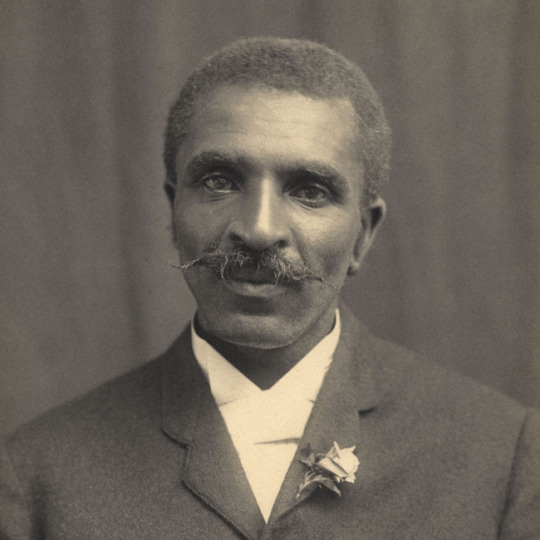
People like George Washington Carver, also known as Mr. Peanut for his revolutionary work creating new products from a single crop, the lowly peanut. And Alice H. Parker, a Black woman who never got the credit, or the fortune, for inventing what we now know as zoned home heating using natural gas. These trailblazers helped America transition to a major agricultural exporter. Their inventions helped farmers increase the harvest to the point that American farmers now feed the world, and those in need. At Feeding America, our work is tied to moving food from farmers to food banks. It is our mission to end hunger in America and many of these Black inventors helped pave the way for U.S. farmers to grow more food.
George Washington Carver (1861-1943)
Born a slave in 1861, George Washington Carver went on to become one of the most prolific agri-business inventors in American history. He invented crop rotation, and more than 300 uses for the peanut. including Worcestershire sauce, cooking oil, and cosmetics. His work is at the foundation of modern farming. It is because of crop rotation and the introduction of grain crops like corn and soybeans, that Feeding America can help our food banks provide for our neighbors in need. Carver helped American farmers feed America.
He was the first African American to earn a bachelor’s in 1894, then a master’s degree in agricultural science from what’s now known as Iowa State University. Carver invented crop rotation. Farmers were struggling to grow anything after years of harvesting a single crop. Carver suggested they plant peanuts, soybeans, and sweet potatoes which would add nutrients to the depleted soil. This method gave farmers a second chance at becoming leaders in agricultural exports.
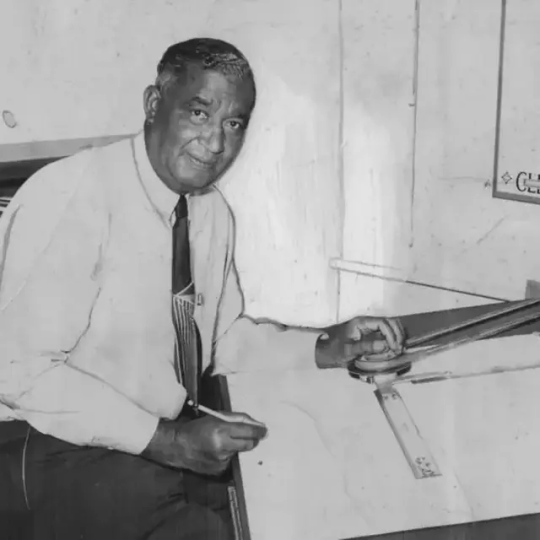
It would be impossible for the Feeding America network of food banks to get the much-needed food they need to nourish feed our neighbors without the work of this man, Frederick McKinley Jones. He invented refrigerated trucks, which help food banks provide fresh produce and meat to their communities safely. And, because of his work, food banks can rely on our massive distribution network to transport fresh produce from farmers across the country on a regular basis. In fact, our network moved 3.8 billion pounds of dairy, produce, and meat -- perishable foods that wouldn’t be available were it not for refrigerated trucks, trains, planes, and ships.
His work revolutionized global logistics. It’s at the heart of what’s now known as “the supply chain.” That is, he made it possible to transport perishable food safely from one place to the next. He co-founded the U.S. Thermo Control Company (Thermo King) which was worth millions by 1949 and later acquired by Westinghouse.
A self-taught mechanic and World War I Army veteran, Jones received more than 60 patents for refrigeration as well as X-ray machines, engines and sound equipment. He was the first African American to receive the Presidential National Medal of Technology.
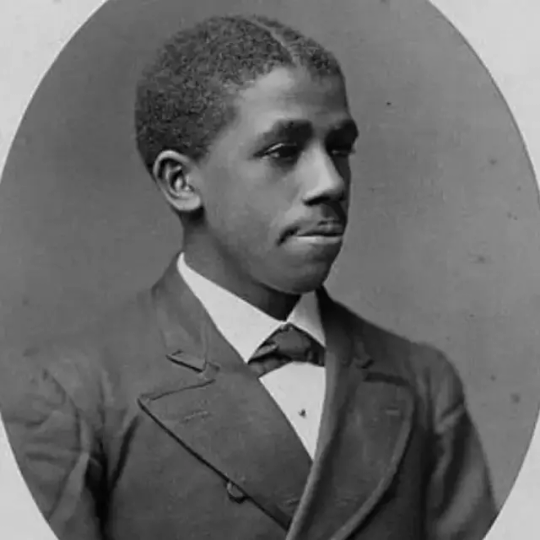
A farmer and a free man before the Emancipation Proclamation, Henry Blair invented two devices to increase agricultural productivity. The first was the corn planter in 1834, and the second was the cotton planter in 1836. His goal was to reduce inefficiencies from manual labor. The Mechanics Magazine published August 6, 1836, described it as “saving the labor of eight men.” Blair’s discoveries helped farmers grow more food for the masses, not just their local communities. For Feeding America, farmers are at the heart of what we do. A large percentage of the food our neighbors receive at their local food pantry is packaged right on the farm where it's grown thanks to our partnership with the USDA. Inventions like Blair's are what fuel the heartland.
While not at the heart of our mission, Feeding America often helps people in need who have to make the tough choice between paying for heat or buying food. During cold winter months, there are many who choose to pay their heating bill and forsake food. They turn to their local food pantry as a stop-gap. The Feeding America network of food banks provides a safe, consistent place for families in need to access food.
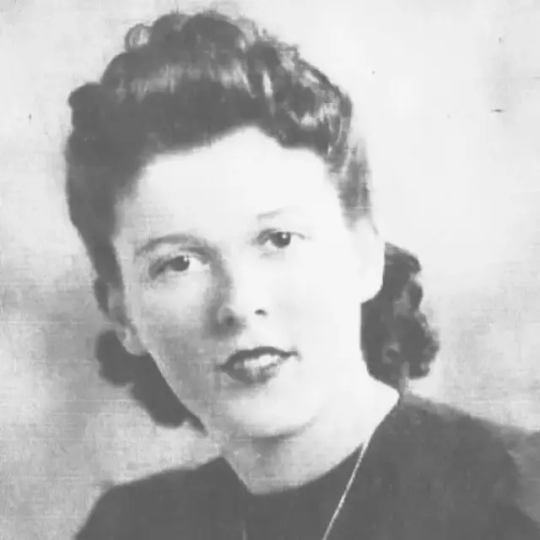
Alice H. Parker, the mother of modern heating, invented the gas-forced air heating system because she too wanted to provide a safe place for families.
Before her invention of the gas furnace, home heating wasn’t safe. Homes were heated with coal or wood-burning fireplaces. Parker was the first to develop natural gas as a cleaner, more efficient alternative to home heating in 1919.
An unsung hero of home heating technology, she revolutionized how we live today. But Parker didn’t have an easy go of it as a Black female inventor. The Civil Rights Movement had yet to give African Americans their rights and the Women’s Liberation Movement was further off. She never profited from her invention. So, we salute her. We know there are many families that struggle with tough choices these days with the rising costs of home heating. But for those who have a warm place to sleep and the modern advances of zoned heat, the next time you adjust the thermostat, say a silent thank you to Alice H. Parker.
5 notes
·
View notes
Text
Yet another thing I love about writing Utapau is that it allows me to casually drop in stuff I learned from the years of extra Paleontology classes I've taken for fun. Ohh, you say it's an ancient ocean-covered planet now covered in sinkholes and grasslands? Wow, that's funny, sounds a lot to me like... Most of America.




Ancient seabed creates limestone rock and chalk, limestone rock absorbs water and is highly carbonate, therefore dissolves easily under slightly acidic rainwater conditions and creates caves and sinkholes.
Both limestone and chalk are mineral rich (because of the organic matter on the ancient seabed) and break down into incredibly rich soils. That's why the prairie ecosystem in my region is called the "Black Belt Prairie", because the soil above the chalk layer was so dense in organic matter it was a deep black color and excellent for growing crops.
(Which led to its destruction because the land was stolen from Native Americans, sold to plantation owners who then used enslaved people to unsustainably harvest a singular crop - cotton- which completely destroyed the rich soil, leaving behind little for the recently-freed sharecroppers, who were then largely caught in a cycle of poverty for the next hundred years until the cattle and catfish farm industries took off in the region, which is now finally beginning to recover. The story of the loss of America's grasslands is not just one of ecological loss, but also one of deep human tragedy as well. I hope this side is not lost in the work I am writing.)
A lot of the plants and minerals and animals I reference in the work Ride or Die are elements I'm familiar with because I know this ecosystem very well, I've spent a lot of time in it. I love it with all my heart, and I want to see it restored to its former glory. I just space up the names a little (or sometimes not at all - toothache grass is toothache grass iykyk) and let this ecosystem breathe.
5 notes
·
View notes
Photo
Once you see this particular distribution, you will start to see it on every single sociological and political map of the US.
And this isn't even the origin story for all of these demographics. It's actually this:

See that yellow bit along the southeast coast? That's the kind of soil you grow cotton in.
The Black Belt is a geological feature; it predates the slave trade. As soon as enslaved African labor was brought to the US to farm that soil, the following 300+ years of political struggle was basically inevitable.
Hundreds of years of oppression - do you think if "just leave" was the answer they wouldn't have already done it?

U.S. Counties where the African American population is 25% or more
27K notes
·
View notes
Text

2024-04-01: "What's In The Delta?" Random Table
This month will probably see the biggest departure in format from the Hexplore24 formula. Since this is based on a real location, my research has already told me where all the locations are so there's not much to explore in the geographic sense. I'll have entries for some of the notable towns, but I've drawn up these tables to populate the in-between spaces.
Scale-wise, this table's features are probably best served by 1-mile hexes. If you roll on the table and get an item that matches any of the the surrounding hexes, that hex is a cotton field instead. Does that mean there's going to be a disproportionate amount of cotton on the map? Yes!
But the weird thing is that this table is actually probably underreporting the amount of cotton grown during this time! Cotton made up over 77% of the agriculture around this time, and almost all the land that wasn't settled for cities is converted to agricultural use.
What's In The Delta? (d20)
Church (roll on Church Denominations)
Juke joint
Service station
Store (roll on Store Type)
Overgrown kudzu zone
Cotton field with gin on site
Cornfield
Sweet potato field
Dead field (nothing grows in the depleted soil)
Indian mound
Woods
Root worker house (spiritualists of the area, also called conjurers, hoodoo workers, or mojo man/woman)
Family cemetery
Swamp
Crop duster airfield
Cotton compress (reduced the size of cotton bales for long-distance transport)**
Cotton field with a cluster of sharecropper shacks
Community gin**
Two small cotton farms with modest houses
Thin place (area where the spiritual realms bleed over into the physical world) (roll on Thin Places)
**Only if next to a railroad line, otherwise a cotton field
Church Denominations (d6)
Chinese Baptist
Southern Baptist
Black Baptist
Methodist
Pentecostal
Mennonite
Store Type (d6)
Dry Goods Store, Chinese-owned
Dry Goods Store, Italian-owned
Dry Goods Store, Lebanese-owned
Grocery Store, Chinese-owned
Grocery Store, Italian-owned
Grocery Store, Lebanese-owned
Thin Places (d6)
Ruined house
Field
Woods
Body of water
Cemetery/Burial ground
Swamp
0 notes
Link
Check out this listing I just added to my Poshmark closet: Eileen Fisher Cozy Waffle Knit High-Waisted Leggings.
0 notes
Link
Check out this listing I just added to my Poshmark closet: Women's GUC Eileen Fischer Black ORGANIC cotton Cropped Pants Size LARGE.
0 notes
Text
How To Start Teak Plantation | Vatican Shona Agrotech

Teak wood has always been in demand because of its sturdiness, durability, and versatility. Even though teak has been used to build various artifacts and vessels since the early ages, it has only recently become more widely cultivated for lawful commercial purposes. For teak plantation, there are various elements that you have to keep in mind so that post cultivation you receive a hefty profit. This article focuses on the details that cultivators need to check while planning a teak plantation.
Site-specific variables
Teak thrives in alluvial soils with pH ranging from 6.5 to 7.5, as well as in warm, humid, tropical climates. Teak exhibited poor growth and morphology in soils that were dry, sandy, shallow, or hardpan, acidic, laterite, black cotton, and waterlogged. It has a high demand for sunlight. It needs between 75 and 100% of sunshine to grow and develop properly. It grows in extremely moist places with an annual rainfall of more than 3,500 mm and occurs from sea level to an altitude of roughly 1200 m with a rainfall regime of 800-2500 mm.
Planting materials
To carry out teak plantation mostly the materials that are used are stumps or seedlings. It is important to nurture the seedlings for one year in a nursery. However, most cultivators prefer stump plantations.
The management process for proper plantation
For growing teak plantations, a suitable piece of land with excellent soil quality and more than 1200 mm of rainfall should be utilized. Prior to the monsoon months, the ground should be carefully tilled and pits of size 45 x 45 x 45 cm should be prepared in spaces of 2 x 2, 3 x 3, or 4 m.
Beware of insect and pest disease
Both mature trees in plantations and seedlings in nurseries are prone to insect lead diseases. This makes frequent pest surveillance necessary. It is important to spray chemicals like monocrotophos or endosulfan to control the severe attacks of pests.
If you are planning to invest in the teak plantation but are confused about where to start then it is always safe to trust the agroforestry experts like Vatican Shona Agrotech. It is one of the most trusted and valued agroforestry companies in India that is known for its expertise in commercial farming.
0 notes
Photo

Today In History Dr. George Washington Carver, scientist and discoverer of over 300 products from the peanut, was successful in getting a Branch Agricultural Experiment Station and Agricultural School at Tuskegee Normal School on this date February 15, 1897. Born a slave on a Missouri farm in 1865, Carver became the first black student and the first black faculty member at what is now Iowa State University. The well-respected botanist led the bacterial laboratory work in the Systematic Botany Department. But at the urging of Booker T. Washington, Carver moved to Tuskegee Institute in Alabama to serve as the school’s director of agriculture. He used his agricultural research to help black farmers become more self-sufficient and less reliant on cotton, the major cash crop of the South. Carver developed numerous products and processes that expanded the range of Southern agriculture. At Tuskegee, Carver developed his crop rotation method, which alternated nitrate-producing legumes such as peanuts and corn with cotton, which depletes the soil of its nutrients. His innovations have been credited with the South’s economic survival in the early part of the 20th century. CARTER™️ Magazine carter-mag.com #wherehistoryandhiphopmeet #historyandhiphop365 #cartermagazine #carter #georgewashingtoncarver #blackhistorymonth #blackhistory #history #staywoke https://www.instagram.com/p/CorgQYeur9n/?igshid=NGJjMDIxMWI=
#wherehistoryandhiphopmeet#historyandhiphop365#cartermagazine#carter#georgewashingtoncarver#blackhistorymonth#blackhistory#history#staywoke
161 notes
·
View notes
Photo

About cotton “the fabric of our lives”
So cotton is a perennial that depletes soil about like corn does. We grew cotton in the south non-stop for hundreds of years. We used black people to tend and pick it. We *did not* rotate the crops, but we did fertilize it, and I challenge the reader to figure out how. Bone meal works wonders for plants, doesn’t it? *hint hint*
When Amerindians plant corn, they plant dead fish first, to ensure a good harvest. Some crops grow better on corpses than others and no soil is ever so rich after that much continuous farming.
0 notes
Text

George Washington Carver was an American agricultural scientist and inventor who promoted alternative crops to cotton and methods to prevent soil depletion. He was one of the most prominent black scientists of the early 20th century. George Washington Carver was born a slave in Diamond Grove, Missouri in 1864 on a farm owned by Moses and Susan Carver. In 1865, before the end of the Civil War, Mary, Carver’s mother and Carver were both kidnapped from the Carver Farm to be resold. Moses and Susan Carver sent out people to try and locate both Mary and an infant Carver. They succeeded in locating Carver in Arkansas, however his mother was never found.
1 note
·
View note
Text


There honestly isn't much George Washington Carver love. Like,first off,he did NOT invent peanut butter,that is a misconception. And he didn't just do sOmEtHiNg wItH pEaNuTs. At that point of time,the soil was basically deprived of nitrogen due to overreliance of cotton as a cash crop. Farmers(most of them black) were starving. The crops looked very lifeless. What Carver did was that he realised that this was a problem and started researching on what crops could help replenish the soil's nitrogen and improve the quality of life for poor black farmers. And one of those crops was peanuts,although he also used sweet potatoes. His research into this helped uplift Southern agriculture. And also,he fought for sustainable farming and was an environmentalist before it was cool. On a side note,he was super good with kids,which is precious ❤❤❤
3K notes
·
View notes